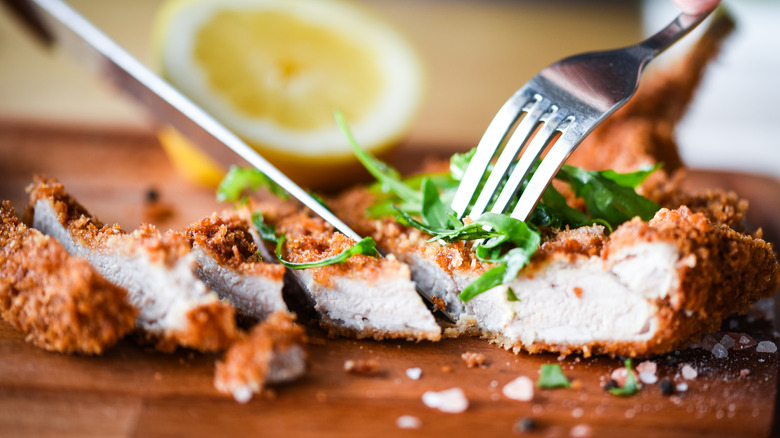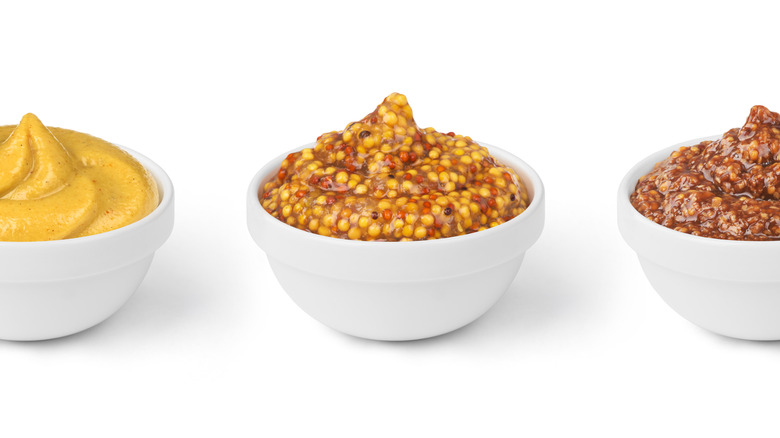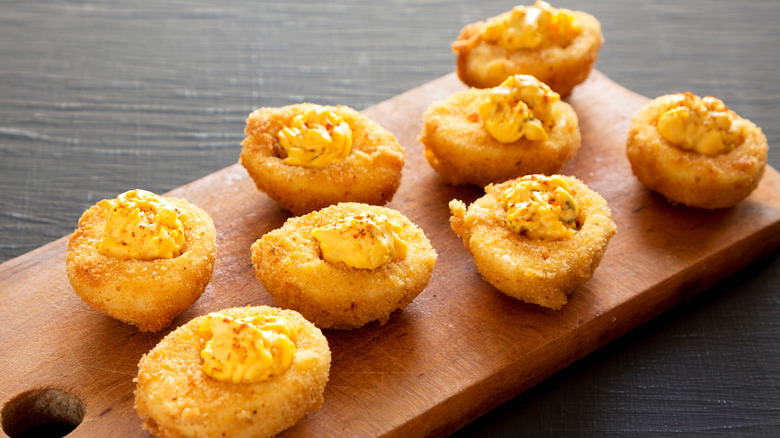The Flavorful Binder That Makes Breaded Meat Less Boring
A breading station is usually pretty standard –- all-purpose flour, beaten egg, and breadcrumbs. Maybe you amp up the dry ingredients with some spices and herbs, or perhaps you add a few dashes of hot sauce to the egg, but otherwise, the breading ingredients can be pretty bland. Plus, by simply dunking a salted piece of protein into seasoned flour and moving on to the rest of the cooking process, you are missing out on serious flavor potential.
This is where your trusty refrigerator door comes into play. That's right, grab that mustard. Using mustard as the binder not only saves you steps; it is also intensely flavorful. Using mustard eliminates the need for both flour and egg, as you can use a brush to paint mustard onto your meat of choice and then dip it into the final coating. All different kinds of mustard will work here — Chinese, brown deli, whole grain, beer-based, creole, yellow, Dijon. Now, your protein is coming in direct contact with a super savory, punchy flavoring. Your hands didn't turn into a gooey mess, and you have way fewer dishes to do.
What is mustard anyway?
Mustard seeds are the base of this zingy condiment. Mustard products have been consumed in various ways since the time of the ancient Egyptians, Greeks, and Romans, but the French are the ones who began to combine mustard with vinegar regularly. The 1700s were when consumers were exposed to a more recognizable version of the condiment, and in 1777, Grey Poupon was invented. Seeds are crushed and sifted to create a mustard powder which is then combined with other ingredients, and the process has not really changed much since then.
Dijon mustard, which comes from and is named after the French region of the same name, combines mustard powder from brown mustard seeds with vinegar, white wine, sugar, and spices. Traditionally, Dijon mustard also includes egg yolks and verjuice, or the juice of unripe white grapes. The taste is tangy and potent, with a zippy spice. French's mustard, on the other hand, is milder in flavor, but still very tangy. The company combines white mustard seed powder with vinegar, sugar, and spices, and the characteristic bright yellow color comes from the addition of turmeric.
Why does mustard work so well for this purpose?
Mustard is a thick, emulsified sauce. Unlike beaten egg, it will easily stick to whatever it is brushed onto. Its pungent taste provides great depth of flavor, without tasting overwhelming mustardy. Instead, mustard imparts savory and salty notes, and the acidic quality helps balance out the richness of a breaded dish.
Once you brush your meat or vegetables in your preferred mustard, dip it into the outer coating. Bread crumbs are classic, of course, but you can use all sorts of crunchy ingredients like finely chopped nuts mixed with something like all-purpose flour to prevent burning, buttery crushed crackers, or crisp potato chips. Instead of using a plate full to the brim, you can instead sprinkle and press the coating onto the food to avoid waste. You can also bread just one side of a filet of fish or pork chop for an even easier process. Pan-fry over medium heat so the protein can cook through without the outer layer burning.
You can additionally riff on a corndog by brushing it with yellow mustard before dunking it in the batter, or try honey mustard and crushed pecans on a salmon filet. For fried deviled eggs, brush the halved egg whites in mustard before rolling them in bread crumbs. The options are endless! Just do yourself (and your dishwasher) a favor, and reach for the mustard the next time you are craving a crispy cutlet.



